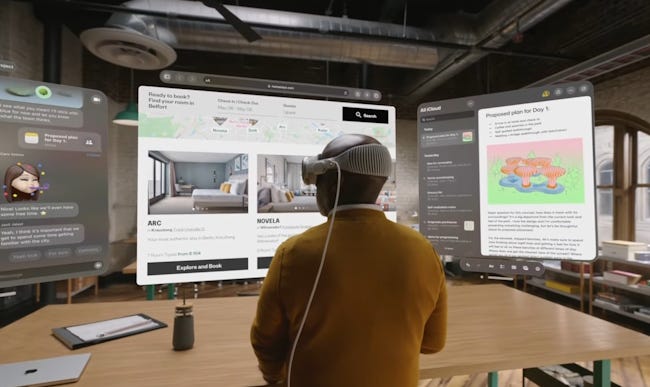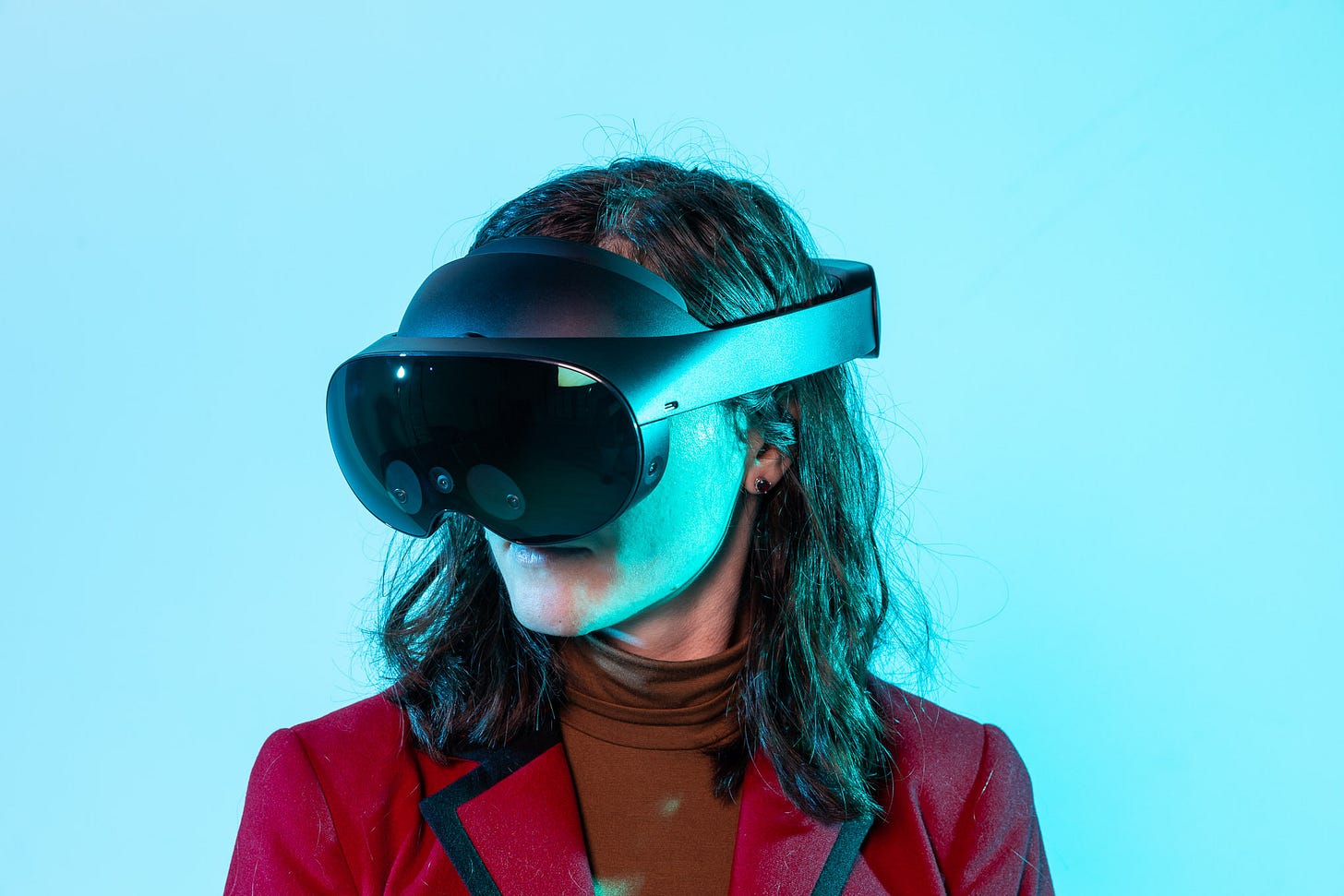Vision Pro has no competition
Compared to what Facebook/Meta has to offer, it's basically in a category all its own
🍭 short and sweet
Apple’s Vision Pro is in a completely different category from Facebook/Meta’s Quest Pro
Apple focuses on augmented reality, while Facebook focuses on virtual reality
Apple focuses on computing, while Facebook focuses on social interaction
Apple has had a vision of releasing an AR computing device for years now. And over a week ago, they finally released the first step of their vision in the form of a mixed reality headset: Vision Pro1.
At first glance, Vision Pro looks like a device that was created to compete with the likes of Facebook/Meta. After all, both companies have created standalone headsets that can be used as wearable computers and to communicate with others.
But despite the similarities, the Vision Pro has so many more things going for it that place it in a completely different category compared to what Facebook has to offer.
AR over VR
Rather than focus on VR specifically, Apple focused their headset on AR. While many apps can be developed as virtual experiences, most methods of interaction involve windows that appear in the real world.
For those who don't know, Meta was originally Facebook. At the time, Facebook had acquired Oculus, a company that helped developed the modern VR headset as we know it.
Eventually, Facebook announced that they would begin focusing on the "metaverse," an emerging technology that combined the virtual world with the real one. According to Facebook, their rebranding as "Meta" was a major step toward this as they wanted to eventually be known as a metaverse company, not a social media company (definitely not anything to do with the whistleblower situation from a few years ago...).
Anyway, when Facebook decided to focus on the metaverse, they started building new headsets that integrated augmented reality2 with their pre-existing virtual reality3. These headsets used controllers that would operate wirelessly and allow users to interact with objects in virtual environments. But Facebook’s idea was to eventually switch to brain-computer interfaces4 that would allow you to control what you do in the metaverse using your thoughts.
But there were issues with this….These headsets were built on virtual reality, so adding AR into a VR-first platform has proven to be somewhat of a challenge. Also, not only are controllers that intercept your brain signals a bit creepy on their own...It gets worse when you consider that it’s being developed by a company known for invasive privacy practices and extremely targeted advertising.
Anyway, this is where Apple's Vision Pro comes into play.
Vision Pro was created with essentially the opposite mindset. Rather than focus on VR specifically, Apple focused their headset on AR. While many apps can be developed as virtual experiences, most methods of interaction involve windows that appear in the real world.
For example, whenever you play a game or watch a movie, the media appears as a floating window, almost like an invisible monitor.
And because Vision Pro was built from the ground up, this means that VR and AR can be seamlessly integrated from the get-go. This is how Apple could create its immersion mode, a way for the virtual world to appear as it's blending in with the real world.
While Meta technically has a feature for "AR passthrough," it is nowhere near on the same level as the combination of VR and AR that Apple offers on their own headset.
But what about the controllers? Well, that's the point of the Vision Pro: it has none.
Instead, it relies on a large amount of sensors and cameras that can detect your hands and eyes, as well as microphones that pick up your voice. Using your eyes and finger gestures, you can select buttons, grow and shrink windows, and even type in text boxes.

While I haven't been able to try the headset as of yet, many early reviews discuss how fluid and effortless the experience feels, especially for a first-generation product.5
You can't reach out and touch the environment like you can in Meta's environments, but that doesn't necessarily seem to be the point.
Computer over social device
Vision Pro is not a social device. It's not a fitness device. It's not a replacement for the real world. It's basically a 3D iPad you wear on your head. That can be good or bad depending on how you look at it.
When Apple announced the Vision Pro, they positioned it as the "next generation of computing." Like how iPhones started the era of mobile computing, the Vision Pro was expected to usher in the era of "spatial computing."
The announcement also prompted a statement from Mark Zuckerberg himself, which clarified his vision of the metaverse:
"Our device is also about being active and doing things. Every demo that [Apple] showed was a person sitting on a couch by themself. I mean, that could be the vision of the future of computing, but like, it’s not the one that I want."
- Mark Zuckerberg, CNN Business
Basically, Zuckerberg's vision for the metaverse is as a social device. It intends to get people to become more social and get more active. This is what the Quest Pro, a headset that's meant to give people a glimpse of what to expect from the metaverse in the future, is designed for.
On the other hand, Apple's vision is not really that different from any of the devices they’ve made in the past.
At its core, the Vision Pro is a wearable computer. It has all the functionality of a MacBook with significantly more productivity. It runs on the same chipset and can even run iPhone and iPad apps. It has social features, but they're the same social features you'd find in any of Apple's other products—iMessage, FaceTime, etc. You can connect an external keyboard and use it like a computer. You can even pull your MacBook's display into the headset itself! Vision Pro is not a social device. It's not a fitness device. It's not a replacement for the real world. It's basically a 3D iPad you wear on your head. That can be good or bad depending on how you look at it.
While the Quest Pro technically has some of these features and is even working on a feature to stream desktops to the headset, Vision Pro not only has these features out of the gate, but Apple intends to build Vision Pro as its own device, not one that has to rely on a PC to function.

I don't doubt that Facebook's goal is to make the metaverse its own standalone thing, but Apple pretty much has the jump on them in this regard—this is how the M1 MacBooks developed so much quicker than Microsoft’s Surface Pro X6. Because of this, I do believe that it will experience much faster growth than Facebook's offerings.
So…where does Vision Pro fit in?
It’s prohibitively expensive for most people, but it’s a much more premium offering than the competition, and Apple has a unique for vision that places it in its own category.
Overall, I don't really think it's fair to put Vision Pro in the same category as what everyone else is creating. Sure, the similarities are there, but Apple is approaching them much differently.
While other companies are still trying to find a use case for their headsets, Apple already seems to have a clear plan of exactly what they want for the Vision Pro and where they will be taking it in the future. It still feels like Facebook is trying to find their footing, even though they've already poured billions upon billions of dollars into the metaverse and it still looks as cartoony as it ever did, whereas visionOS7 looks like something from the next decade.
This is why I’m not too upset by the $3500 starting price. Sure, it’s prohibitively expensive for most people, but it’s a much more premium offering than the competition, and Apple has a unique for vision that places it in its own category.
It’s gonna be interesting to see how Apple builds on this formula going forward...
This week’s question…
Which idea of mixed reality do you think is the future: Meta’s vision of social interaction or Apple’s vision of computing?
Leave a comment and let me know your thoughts!
Anyway, just wanted to share that with you guys. Thanks for joining me, and I’ll see you all around. Adios! 👋
→ Austin from nexgen
Read next
A headset developed by Apple that allows digital objects to appear as if they existed in the real world (also known as “augmented reality”, or AR). It can also create virtual environments around users (also known as “virtual reality”, or VR).
A technology that uses displays to make virtual objects and windows appear as if they existed in the real world (e.g. Apple’s website has options that let iPhone users use AR to place 3D models of their products in the real world).
A technology that uses displays to create a virtual environment around the user. Oculus focused primarily on virtual reality headsets before Facebook purchased them and began integrating augmented reality.
A device that can read a person’s brain signals and interpret them as input for a computer.
The first product in a product category that was developed by a company (e.g. the Vision Pro is a first-generation product for Apple since it was the first commercially-available mixed reality headset they made).
Microsoft’s first modern attempt at a computer that ran on a smartphone chipset.
The software that Vision Pro runs on.










A fellow YouTube creator. Neat!